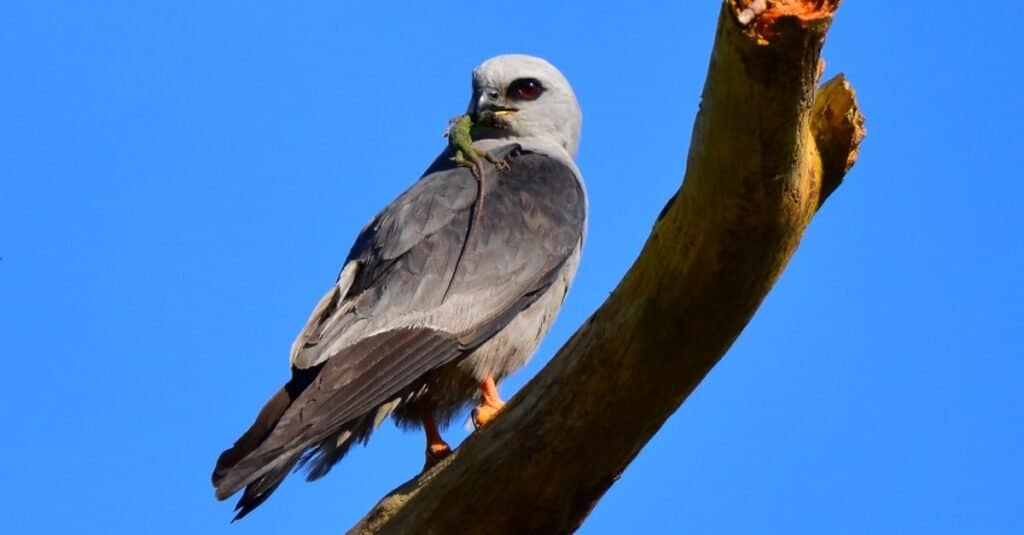Mississippi Kite
Ictinia mississippiensis
The Mississippi kite tends to form a monogamous pair bond for life
Advertisement
Mississippi Kite Facts
- Prey
- Insects, rodents, snakes, birds, bats, frogs, and turtles
- Fun Fact
- The Mississippi kite tends to form a monogamous pair bond for life
- Estimated Population Size
- 300,000
- Biggest Threat
- Habitat loss, poisoning, and hunting
- Most Distinctive Feature
- The red eyes
- Other Name(s)
- Mosquito hawk, blue snake-hawk, and hovering kite
- Wingspan
- 3 feet
- Incubation Period
- 29-32 days
- Habitat
- Hardwood forests, prairies, and urban environments
- Predators
- Raccoons, snakes, crows, owls, and other birds of prey
- Diet
- Carnivore
- Type
- Bird
- Common Name
- Mississippi Kite
- Number Of Species
- 1
- Location
- United States, Central and South America
- Nesting Location
- Trees
- Age of Molting
- 25-30 days
- Migratory
- 1
View all of the Mississippi Kite images!
The Mississippi kite soars gracefully through the air, searching diligently for food below.
They are among the most common birds of prey in the southern parts of the United States. Entire groups of these birds can be seen roosting together in the summer. There are many fun facts to discover about this fascinating bird of prey.
3 Amazing Mississippi Kite Facts
- One of the most interesting fun facts is that the Mississippi kite has an unusual call that sounds a bit like a squeaky toy.
- The Mississippi kite gains weight in August to prepare for the annual migration.
- The Mississippi kite has incredible eyesight that can spot small flying prey from a long distance.
Where to Find the Mississippi Kite
The name of this bird is a bit of a misnomer. The Mississippi kite can be found roosting and hunting near hardwood forests, open prairies, and even urban and suburban neighborhoods throughout the entire central and southeastern United States, sometimes even appearing in locations as far north as New England. Its migratory route takes it all the way down to South America as well.
Mississippi Kite Nests
Mississippi kites will take up residence in elm, oak, mesquite, or eastern cottonwood trees, just high enough to prevent predators from easily accessing their roost. The nest is constructed out of twigs and green leaves.
Mississippi Kite Scientific Name
The scientific name of the Mississippi kite is Ictinia mississippiensis. Ictinia, derived from the Greek word for a kite, contains only one other species, the Plumbeous kite of Central and South America. Mississippiensis is a Latinized version of the state with which it’s commonly associated.
Mississippi Kite Size, Appearance, and Behavior
The Mississippi Kite is a slender raptor, measuring about a foot tall and weighing less than a pound. It can be identified by the subdued color pattern, including a white or light gray head and stomach, dark gray wings, and black wingtips and tail. Other prominent features include red eyes (surrounded by a circular pattern of gray feathers), a sharp gray-colored beak, and yellow talons. Males and females are fairly similar in appearance, but juveniles look very different; identification is a matter of finding the dark brown streaks along the chests and under wings, and a banded tail.
The Mississippi Kite is an excellent flyer. It spends a great deal of time in the air, gliding along updrafts, while sometimes executing incredible aerial maneuvers to catch fast-moving prey. Unlike some birds of prey, this is a highly social species that roost together in large flocks and does not keep an individual territory. Sometimes it can be heard making a high-pitched two-note whistle-like call.
 green anole lizard (Anolis carolinensis) in its beak.” class=”wp-image-96161″/>
green anole lizard (Anolis carolinensis) in its beak.” class=”wp-image-96161″/>Migration Pattern and Timing
After the completion of the breeding season, the Mississippi kite does travel south toward its Central and South America range for the winter; most of them eventually settle in Brazil and Argentina. The migration proceeds in small groups of 20 to 30 birds at a time.
Mississippi Kite Diet
These Kites are carnivorous and opportunistic birds. It consumes almost any kind of meat it can find.
What does the Mississippi kite eat?
The diet of the kite mostly consists of insects. Grasshoppers, cicadas, beetles, moths, dragonflies are among its favorite food. It will also supplement this with frogs, snakes, turtles, bats, rodents, and smaller birds.
Mississippi Kite Predators, Threats, and Conservation Status
These kite faces very few natural threats in the wild, but some birds do fall victim to predators, human hunters, poisoning, collisions with vehicles, and other accidents. It is currently classified by the IUCN Red List as a species of least concern. The species as a whole is protected by the Migratory Bird Treaty Act in the United States.
What eats the Mississippi kite?
An adult kite has few consistent predators, but eggs and young hatchlings are sometimes preyed upon by raccoons, snakes, crows, owls, and other birds of prey. Groups of kites will emit a loud call and mob a predator that gets too close to the nests.
Mississippi Kite Reproduction, Young, and Molting
These kites form intimate pair bonds that generally last for life. Courtship may involve some form of aerial acrobatics but generally doesn’t continue once the bond is established. The breeding season occurs every year between May and July and produces one or two (rarely three) eggs. During the month-long incubation period and the subsequent brooding, the parents take turn protecting, feeding, and keeping the young warm.
By the five-week mark, the youngsters have already ventured out from the nest and begun to fly. However, they will continue to be fed by the parents until about eight weeks after hatching. They are considered to be sexually mature by around one or two years of age. The lifespan of the typical kite is about eight years, but the oldest known member of the species had a lifespan of 11 years.
Mississippi Kite Population
The estimated population size of these kites is around 300,000. The species was in a state of decline by the middle of the 20th century, but it has since staged a comeback and is now expanding its range throughout the United States.
View all 164 animals that start with MMississippi Kite FAQs (Frequently Asked Questions)
Does the Mississippi kite migrate?
Yes, it migrates south toward warmer environments after the end of the breeding season.
How many eggs does the Mississippi kite lay?
It lays one or two white-colored eggs (rarely three) per season.
How fast does the Mississippi kite fly?
The flight speed hasn’t been accurately measured, but it normally cruises along at lower speeds and then executes a fast dive when it spots prey.
What is the Mississippi kite’s wingspan?
One of the fun facts is that the Mississippi kite has a wingspan of around 3 feet long.
What does a Mississippi kite eat?
The diet consists of insects, rodents, snakes, frogs, birds, and other small animals.
What can be used to scare or repel a Mississippi kite?
Usually waving your arms or hat around may deter a bird attack. If you have a more permanent issue with bird attacks around your home or business, then sometimes safe sonic devices or bird repellers will work well. But the best thing to do is to simply leave them alone and give them plenty of space (preferably at least 50 yards). Since it’s protected by Migratory Bird Treaty Act, people should not attempt to bother an adult kite or tamper with the nests or eggs. Fortunately, the Mississippi kite almost never attacks people unless you happen to wander a little too close to the nest, and even then only rarely.
What birds do Mississippi kites avoid?
They generally try to avoid owls and larger birds of prey.
Is a Mississippi kite rare?
The species is very common throughout its entire range. Numbers appear to be increasing.
Is a Mississippi kite a hawk?
There isn’t really a clear difference, in scientific terms, between a kite and a hawk. In fact, some experts place the Mississippi kite within the group called the buteonine hawks. It’s closely related to species like the red kites and slender-billed kites but also the black-collared hawk and crane hawk. The full relationship of all these species isn’t entirely clear and has yet to be worked out.
How do you identify a Mississippi kite?
Identification is fairly easy. The white body, gray beak and wings, black tail feathers, red eyes, and yellow talons are all important aspects of its appearance. This species is sometimes mistaken for the northern harrier, but identification is a simple matter, since the solid colors and slender body of the Mississippi kite are obvious giveaways.
Is the Mississippi kite endangered?
The Mississippi kite is not endangered. It’s actually a species of least concern, the highest possible conservation status, meaning population numbers are very healthy and robust. It requires no special conservation efforts to protect it.
Will Mississippi kites eat hummingbirds?
Yes, they do sometimes feed on hummingbirds, but it’s not a common part of their diet.
Thank you for reading! Have some feedback for us? Contact the AZ Animals editorial team.
Sources
- Animal Diversity Web, Available here: https://animaldiversity.org/accounts/Ictinia_mississippiensis/
- Audubon, Available here: https://www.audubon.org/field-guide/bird/mississippi-kite
- The Peregrine Fund , Available here: https://www.peregrinefund.org/explore-raptors-species/kites/mississippi-kite

















